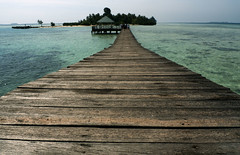Indonesia has a flair for disorganisation, and this was exemplified during my holiday last week, when I flew to Lombok, using Jakarta’s old domestic flight terminal. This, and Lombok’s terminal are utter chaos, and the only way to survive them is to assume the guise of a detached observer, laugh at the various goings on, and not to worry about niceties such as getting on the correct plane, or collecting your luggage at the end.
The check in was smooth enough, but as you pass though the gate to board the flight you are deposited in a long corridor, with several other gates emptying into it, four different planes off it, and nary a sign or official in sight. As I have previously managed to board the wrong flight (though not in Indonesia), I was keen to avoid a repetition of that colossal blunder. I followed the flood of people down a hidden staircase onto the tarmac, where my odds doubled, as only two of the planes seemed ready to receive passengers. I spotted a few people who had been waiting at my gate and followed them; I don’t what method of divination they were using, but we all managed to board the correct plane, or at least a plane to the correct destination.
The flight itself was uneventful enough, despite the very retro style plane, and I arrived in Lombok’s capital Mataram a few hours later. The arrivals hall is pretty small, and it seems even smaller when it’s full of a couple of planes worth of passengers, and an equal number of porters complete with luggage trolleys that no one wants. There are two “carrousels”, each with a ruck of people four deep around them, and no screen to tell you which to use. I say “carrousel” because they were nothing of the sort. A carrousel is where you bags are placed onto a circular track, and slowly rotate until you collect them; these are just single tracks that the bags are loaded onto, and then blasted out into the middle of the room where they lie in a heap on the floor, with the crowd rooting through them in a frenzy. This was all a bit much for me, so I wandered around in a daze for a little while, by which time the crowds had thinned out and I could see my scuffed bag lying forlornly on the ground.
The return home was eerily similar. I arrived in Jakarta easily enough, and on leaving the plane found myself on the tarmac with the bulk of the terminal in front of me, masses of possible doors and staircases to take, and nary a sign or official in sight. There is strength in numbers, so a group of passengers clumped together and went to find a way home; we peered up staircases and through doors, hoping for some official looking entrance. There was none, but some of the more adventurous of our posse forged ahead, and found a ratty looking staircase up into the terminal, and ultimately to the baggage reclaim hall.
In Jakarta, they at least have carrousels, six of them in fact, and a board telling you which to use; unfortunately the board doesn’t seem to have updated since 1982, so you are left with a choice of the six carrousels, each with a huge scrum of people around it, and no accurate indication of which one your bag will be on. Remembering my technique from the flight to Lombok, I allowed my mind to drift away on a sea of tiredness and irritation, day dreaming about possible future holidays to Singapore or Switzerland, or other well organised countries, and by the time my fantasies were over the crowds had again thinned and I was able to spot my poor bag circulating by itself around one of the carrousels.


